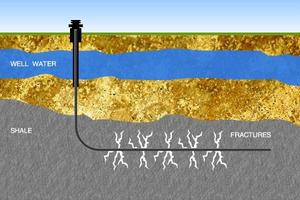FrackingFracking: fact vs. fiction
In communities across the United States, people are hearing more and more about a controversial oil and gas extraction technique called hydraulic fracturing — aka, hydro-fracking; controversies pivot on some basic questions: Can hydro-fracking contaminate domestic wells? Does it cause earthquakes? How can we know? What can be done about these things if they are true? Experts making presentations at the Geological Society of America (GSA) meeting this week in Charlotte, North Carolina, will address these and related critical questions

Schematic graphic of hydrofracking technology // Source: uconn.edu
In communities across the United States, people are hearing more and more about a controversial oil and gas extraction technique called hydraulic fracturing — aka, hydro-fracking.
Controversies pivot on some basic questions: Can hydro-fracking contaminate domestic wells? Does it cause earthquakes? How can we know? What can be done about these things if they are true? A Geological Society of America (GSA) release reports that a wide range of researchers will address these and related critical questions at the GSA Annual Meeting this week in Charlotte, North Carolina.
“When people talk about contamination from hydraulic fracturing, for instance, they can mean a lot of different things,” says hydrogeologist Harvey Cohen of S.S. Papadopulos & Associates in Bethesda, Maryland. “When it’s what’s happening near their homes, they can mean trucks, drilling machinery, noise.” These activities can potentially lead to surface water or groundwater contamination if there are, for example, accidental fuel spills. People also worry about fracking fluids leaking into the aquifers they tap for domestic or municipal water.
On the other hand, when petroleum companies talk about risks to groundwater from hydro-fracking, they are often specifically referring to the process of injecting fluids into geologic units deep underground and fracturing the rock to free the oil and gas it contains, says Cohen. This is a much smaller, much more isolated part of the whole hydraulic fracturing operation. It does not include the surface operations — or the re-injection of the fracking waste fluids at depth in other wells, which is itself another source of concern for many.
All of these concerns, however, can be addressed, says Cohen, who will be presenting his talk on groundwater contamination and fracking on the morning of Wednesday, 7 November. For instance, it has been proposed that drillers put non-toxic chemical tracers into their fracking fluids so that if a nearby domestic well is contaminated, that tracer will show up in the well water. That would sort out whether the well is contaminated from the hydro-fracking operations or perhaps from some other source, like a leaking underground storage tank or surface contaminants getting into the groundwater.
“That would be the 100 percent confident solution,” says Cohen of the tracers.
Another important strategy is for concerned citizens, cities, and even oil companies to gather baseline data on water quality from wells before hydro-fracking begins. Baseline data would have been very helpful, for example, in the case of the Pavillion gas field the Wind River Formation of Wyoming, according to Cohen, because there are multiple potential sources of contaminants that have been found in domestic wells there. The Pavillion field is just one of multiple sites now being studied by the U.S. Environmental Protection Agency (EPA) to learn about past and future effects of hydro-fracking on groundwater.
The same pre-fracking science approach is being taken in some areas to evaluate the seismic effects of disposing of fracking fluids by injecting them deep underground. In Ohio and Texas, this disposal method has been the prime suspect in the recent activation of old, dormant faults that have generated clusters of low intensity earthquakes. So in North Carolina, as well as other places where fracking has been proposed, some scientists are scrambling to gather as much pre-fracking seismic data as possible.
Interesting hydro-fracking presentations and sessions will run throughout the meeting, include the following:
Monday
Paper No. 125-7
Local and Regional Water Supply Planning to Evaluate and Manage Hydrofracking
Tuesday
Paper No. 135-1
Overview of the potential risks of shale gas development and hydrofracturing on water resources in the United States
Paper No. 142-2
Finding frack facts: The literature of hydraulic fracturing
Wednesday
Paper No. 219-8
Groundwater contamination from hydraulic fracturing - How will we know?
Paper No. 219-14
History and development of effective regulation of hydraulic fracturing: the genesis of Colorado rule 205A
Paper No. 241-2 (Posters)
Pre-hydrofracking regional assessment of central Carolina seismicity
Paper No. 241-1 (Posters)
Insights on induced seismicity in Ohio from the Youngstown M4.0 earthquak
